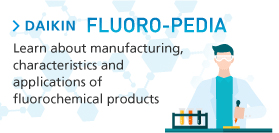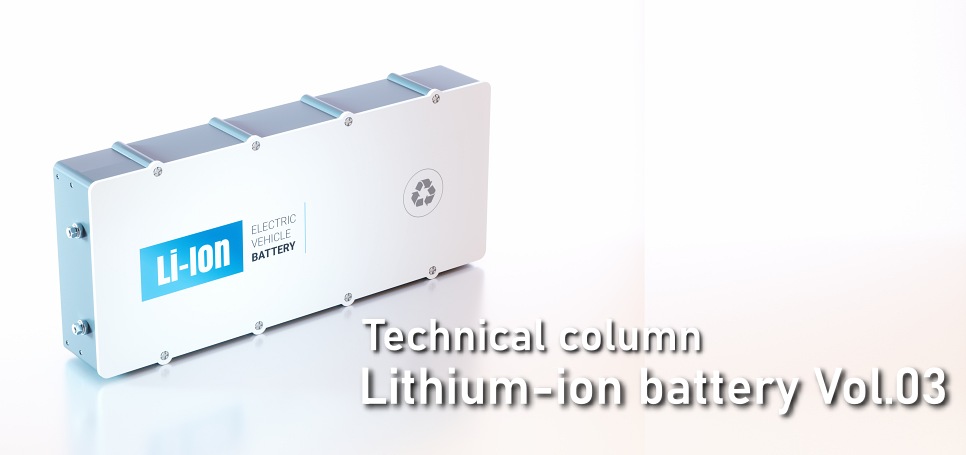
![]()
Serial column
11/2024
[Battery materials] Vol.3 Dry process for lithium-ion batteries
Takanori Suzuki
Suzuki Material Technology and Consulting Co., Ltd.
[Serial column] In this article, market trends and development of battery materials will be discussed by Takanori Suzuki, who has many years of experience developing lithium-ion battery materials and is currently consulting at Suzuki Material Technology and Consulting Co., Ltd. The third article in Daikin’s Battery Materials series focuses on “Dry process for lithium-ion batteries.”
【Serial column : Battery materials】
>Vol.01 Lithium-ion batteries and fluoromaterials
>Vol.02 Binder for lithium-ion batteries
Vol.03 Dry process for lithium-ion batteries
-
The entire battery industry is talking about dry processes and creating methods that remove solvents or water from the fabrication of electrodes for lithium-ion batteries. The following is an explanation of why dry processes, the required implementation technologies, and process environments.
1. The manufacturing process for lithium-ion batteries and problem areas
The processes for manufacturing typical lithium-ion batteries are divided into two steps. The first step is the process lasting until the electrodes are made - the “preceding process”. The second step is assembling the cells into batteries - the “post process”. A coating method is used for the fabrication of electrodes during the preceding process. An active material and a conductive agent are dispersed within a solvent containing a dissolved binder to form a slurry. The slurry is then applied to a current-collecting foil. Once dried, it is pressed and formed into an electrode. Electrodes are normally coated on both sides of the foil.
PVdF is used as a cathode binder. An organic solvent called NMP (N-Methyl-2-pyrrolidone) is used in the cathode manufacturing process. This organic solvent is combustible and production facilities must meet explosion-proof specifications. As NMP has a high boiling point of around 204°C and a high drying temperature, between 120°C and 130°C, large amounts of energy are necessary in the drying process, creating large volumes of CO2 emissions.
Another major issue is the disposal of NMP. It should not be consumed or incinerated; instead, it must to be recovered. The recovery equipment and the costs involved present a manufacturing burden.
The anode has a large latent heat of water evaporation, so the drying energy is unexpectedly large. Considering the CO2 emissions and costs, these are industry issues we would like to avoid this.
Fig.1 Conventional electrode fabrication processes (wet processes)

2. Dry processes as a solution
The disadvantages of NMP are clear. There was a time when the move away from organic solvents was gaining attention. Early on, there were calls for cathode slurries be water based. However, as the performance of active cathode materials improved, the active material itself would become averse to water. It was noted that active performance degrades as a result of being exposed to moisture for long periods of time. Even now, there is no indication of a significant move towards processes using water-based slurries for cathode.
One of the methods developed to address solvents consists of dry processes. Dry processes are methods which use no water, organic solvents, or other liquids. Also, electrodes are not made with the coating process, removing the need for drying or solvent recovery. The electrode powder is made by mixing the powder of the active material, the conductive agent, and the binder. This mix is then formed into a sheet and the electrode is created.
While dry processes have the advantage of eliminating the need for drying and recovery, it is more difficult to easily create a thin electrode layer. High-level technology is required to ensure that the electrode mixture layer is uniform and that electrodes are made to be very thin. Currently, the thickness of the electrode in the mixture layer is about 50-100μm (not including the current-collecting foil and only one sided). Creating a sheet of active material with this thickness is not a straightforward process.
Conversely, the coating method is well-suited for creating electrodes of such thinness.
Two main dry processes are under development. One method involves mixing the fine powder of a thermoplastic resin binder with an active material and a conductive agent. The binder resin is then melted by applying heat, bonding together the active material and the conductive agent. The other method involves PTFE (polytetrafluoroethylene) as a binder resin, which is kneaded while applying an appropriate shearing force. The PTFE is then fibrillated to form a binder, after which it is then thinned using a press.
3. Binder for dry processes
There are binders suitable for each respective processing method.
3-1. Thermoplastic resin binder
Most of the cathode binders used in current liquid-based lithium-ion batteries are PVdF based. This is because PVdF is electrochemically stable and does not decompose, even when there are extremely high levels of oxidation potential involved. As PVDF is the industry standard for lithium-ion batteries, most development includes the use of fine powder comprised PVdF-based material as a binder.
Polymerization methods for PVdF include suspension polymerization and emulsion polymerization. The largest difference between these methods is the primary particle diameter. Generic suspension-polymerized PVdF is a powder consisting of pearl-like particles that are 50 to several hundred μm in size. Emulsion polymerization products have smaller particle sizes. Emulsion-polymerized PVdF, features primary particles that are several tens to hundreds of nm in size. This is the secondary particle, which is several μm to several tens of μm in size. PVdF homopolymer can be crushed relatively easily to a particle diameter that is approximately the same as that of a primary particle. This creates a high possibility that it would function efficiently as a binder within the powder blending and thermal fusion processes. Due to the large size of the particle diameters involved in suspension-polymerized PVdF, the need arises to pulverize the suspension-polymerized PVdF particles so that they are, at minimum, several μm in size (for this application). This pulverization to a single-digit particle size (in terms of μm) is not very realistic due to the costs involved, as the particle diameter sizes almost reach their physical limits. For this reason, the PVdF binder is often prepared by making use of the emulsified polymer product (powder) as is.
3-2. PTFE binders
The next dry process involves PTFE fibrillation through the application of a shearing force. The active material and the conductive agent are entangled together with the fine fibers to form a mass, which is then formed into a sheet via pressing or a similar method. This becomes the electrode.
Fig.2 Electrode preparation process (dry process using PTFE binders)

In addition to undergoing fibrillation, PTFE also features incredibly high levels of oxidation resistance. Therefore, it is the only material under consideration for this method as a cathode binder for dry process electrodes.
3-3. Problems with dry processes
Solvent-free dry processes have many advantages and constitute promising electrode fabrication. There are still several hurdles to overcome.
Fig.3 Problems with dry processes
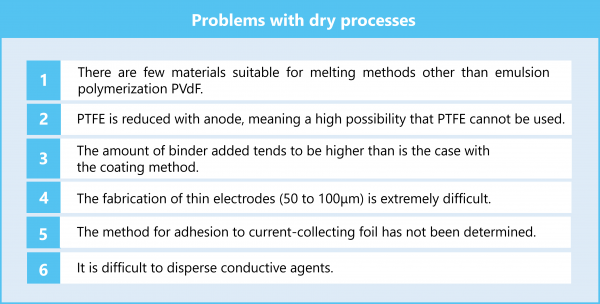
4. Daikin’s initiatives
Daikin is progressing the development of a PTFE which can be used as a sheet with a smaller amount of additives. The company is leveraging their vast fluoropolymer experience, particularly their PTFE design and synthesis technologies. Thanks to Daikin’s emulsion polymerization technologies and PVdF-based materials, we can propose binders for both cathode and anode.
Daikin also offers SWCNT as a conductive agent, which shows excellent conductivity when deployed for dry processes.
Dry processes require “composite techniques involving materials and processing” -- Daikin’s product lines and technology provide the innovative material solutions needed to achieve these new processes.
RELATED ARTICLES
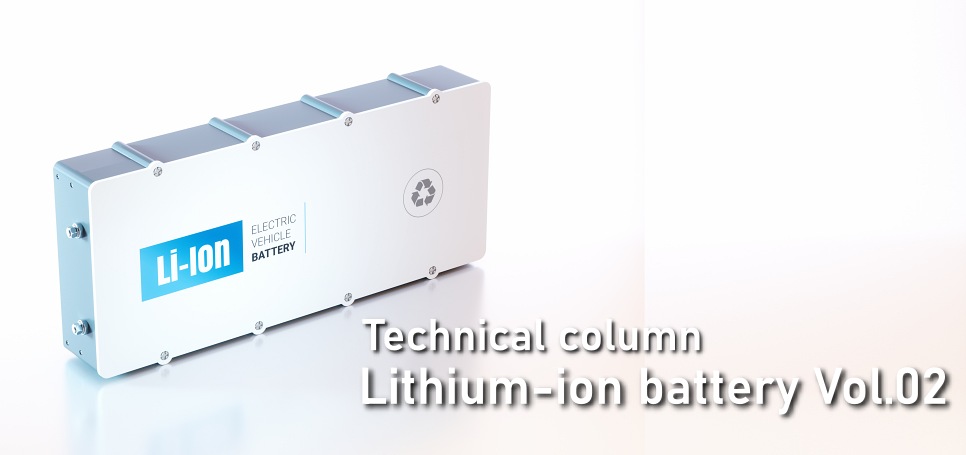
Serial column
10/2022
[Battery materials] Vol.2 Binder for lithium-ion batteries
The market trends and development movements of battery materials are featured by Takanori Suzuki, who has been engaged in the development of lithium-ion battery materials for many years and is currently a consultant for battery materials at Suzuki Material Technology and Consulting Co., Ltd. The theme of the second column of the series is “Binder for lithium-ion batteries.”
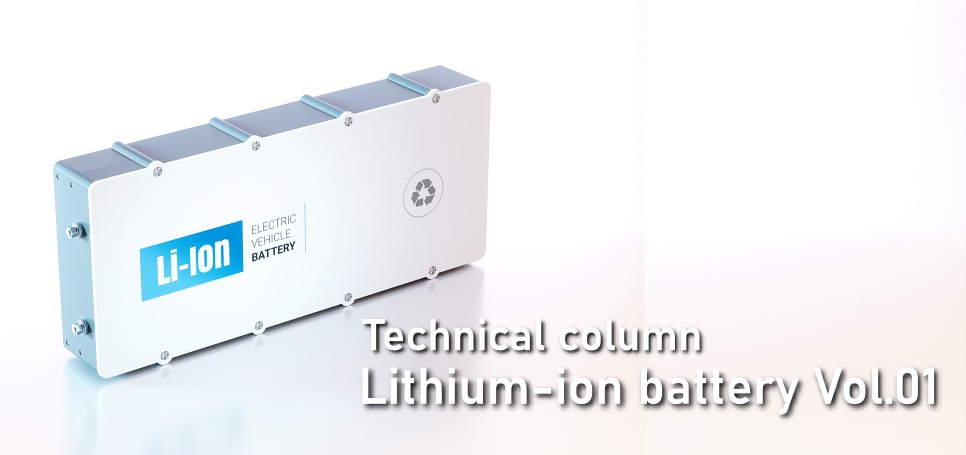
Serial column
08/2022
[Battery materials] Vol.1 Lithium-ion batteries and fluoromaterials
The market trends and development movements of battery materials are featured by Takanori Suzuki, who has been engaged in the development of lithium-ion battery materials for many years and is currently a consultant for battery materials at Suzuki Material Technology and Consulting Co., Ltd. The theme of the first column of the series is “Lithium-ion batteries and fluoromaterials.”
